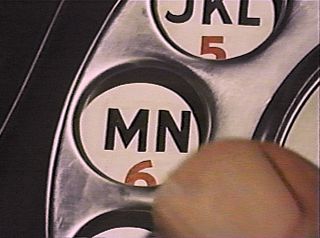Timing a Murder
In Dial M for Murder, the murder is organized by Tony (Ray Milland), who is aware that his wife, Margot (Grace Kelly), had and possibly still is having an affair with Mark (Robert Cummings), who his visiting from out of town. Tony has been following an old school acquaintance and ex-convict, Swann (Anthony Dawson), with the intention of enlisting Swann to kill Margot. In the second major sequence of the film, Tony invites Swann to his apartment under false pretenses, reveals his plan and offers Swann a large sum of money in return for the murder. Swann accepts and plans to murder Margot while Mark and Tony are at a social function and she is home alone. Swann will break into the apartment at a few minutes before eleven o'clock and wait behind a curtain while Tony phones Margot, thereby drawing her out of her bed and into Swann's hands.
Swann gets to the apartment on time and awaits Tony's call. The attack is dramatically structured. The precision timing starts from the point at which Margot picks up the phone. As the camera pans around her and back to the frontal shot of Swann braced for attack, it is exactly thirty seconds before he lunges. The struggle follows and itself lasts for exactly thirty seconds before Margot fatally stabs Swann with the scissors. Then exactly thirty seconds after the stabbing, Margot picks up the phone and asks for help. What appears on the surface to be a naturally played-out murder sequence, the ebb and flow of which is dictated by Margot's persistence in not hanging up and her strength in resisting Swann, is in fact a carefully-engineered narrative construct. Hitchcock parcels out the time allotted to each stage in the sequence with scientific precision. This timing has the effect of making the murder self-contained. It is a story within a story. This little story has an introduction or build-up, a main action, and a conclusion, and these parts are all of equal length. This self-contained flurry of activity stands separate from the rest of the single-location film as the single outburst of physicality and action. The decisive nature of its beginning, middle and end serve to increase this sense of a unified story within a bigger story.
The emotional responses to the various parts of the story are fear for Margot (perhaps combined with malicious impatience) followed by mild horror at the sight of two humans struggling to the death, followed by a degree of relief at Margot's survival (perhaps combined with perverse curiosity at Swann's pain). Hitchcock allows each of these sentiments equal running time. We are literally run through the gamut of emotions in a very deliberate and unified way.
Only when Swann falls and Margot picks up the phone does our fear for Margot's safety fade away. This sense of closure provides us with a natural break in the film and allows us to regroup and refocus our attention. Something has come to a definite ending and, now, we must move on. This effect is dramatically reprised in Psycho.

|

